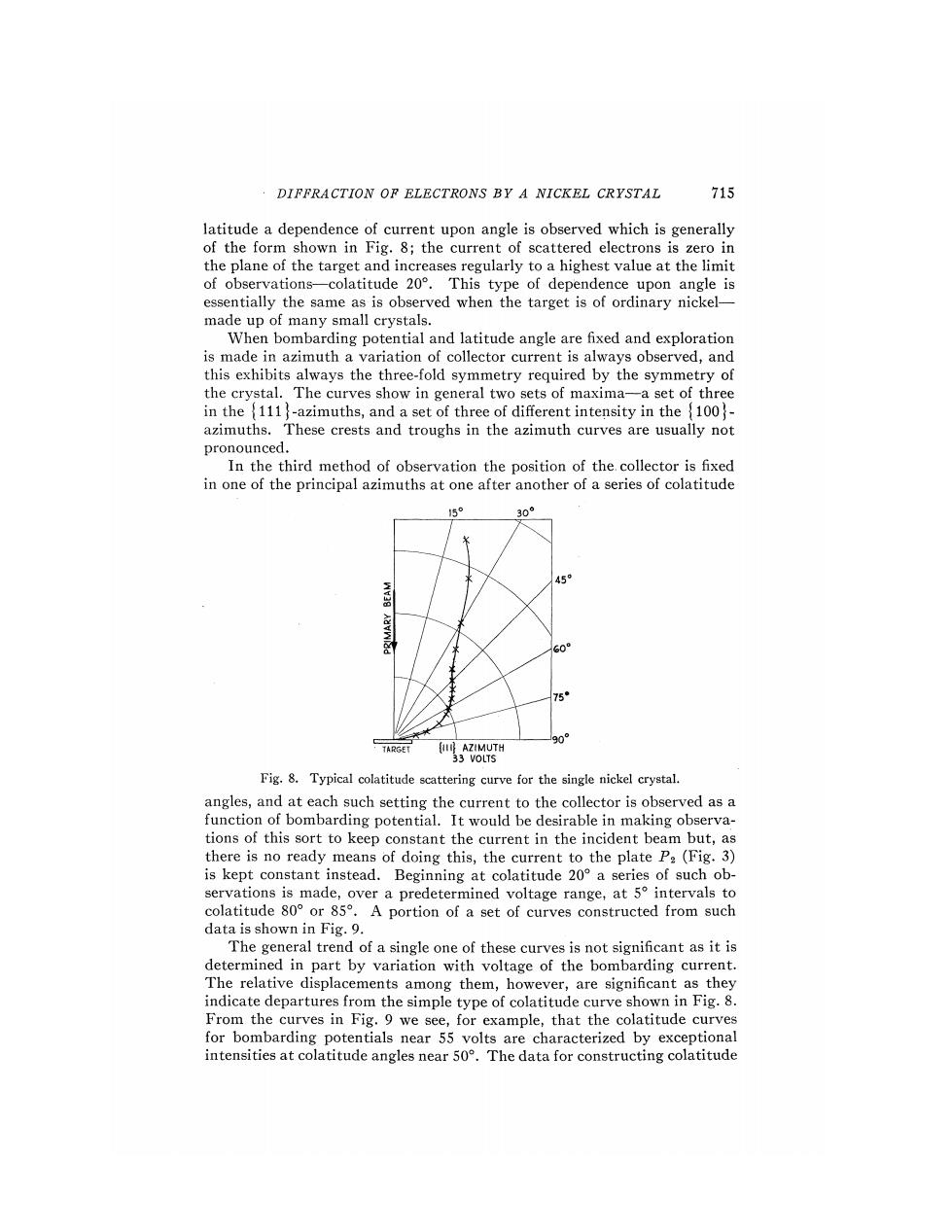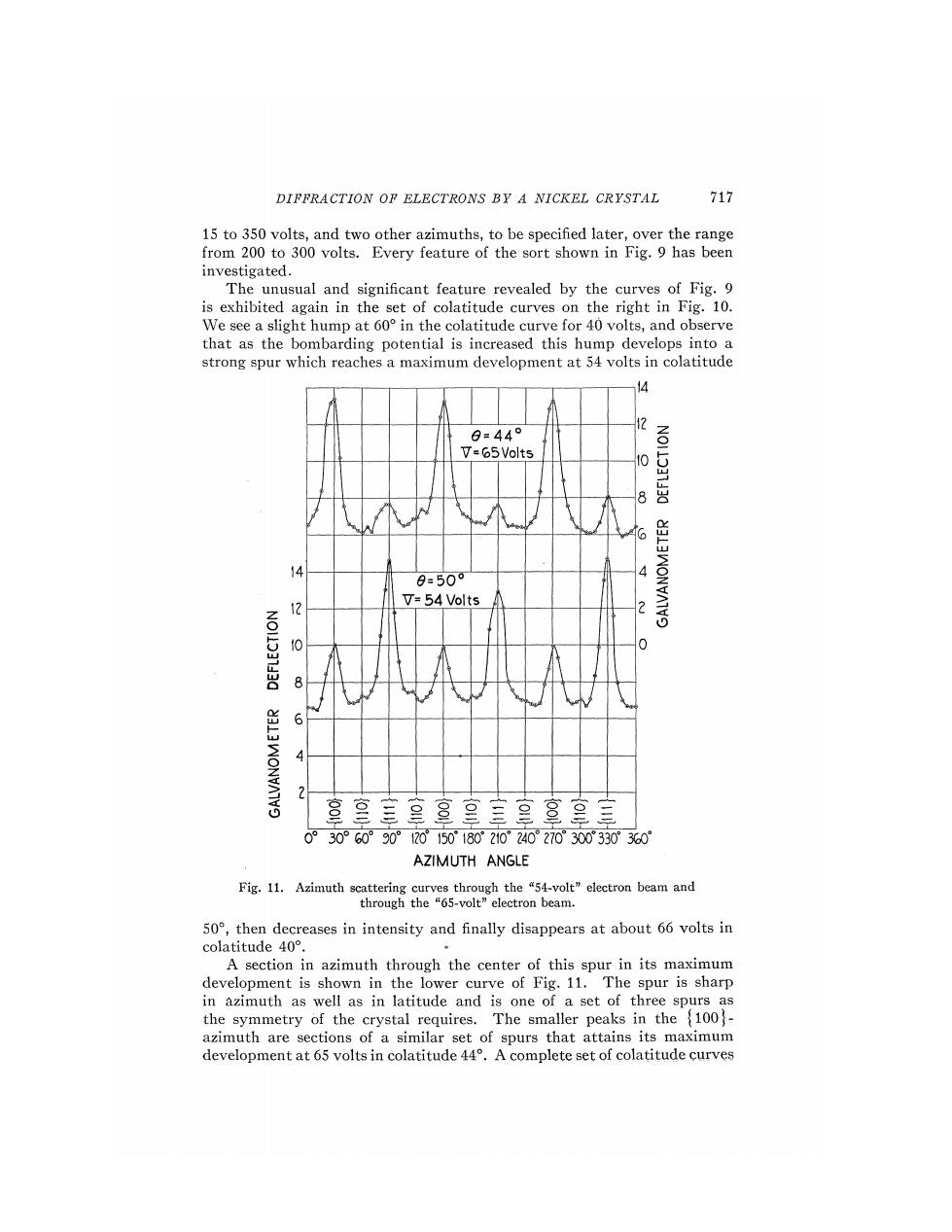
DIFFRACTION OF ELECTRONS BY A NICKEL CRYSTAL 715 latitude a dependence of current upon angle is observed which is generally of the form shown in Fig.8;the current of scattered electrons is zero in the plane of the target and increases regularly to a highest value at the limit of observations-colatitude 20.This type of dependence upon angle is essentially the same as is observed when the target is of ordinary nickel- made up of many small crystals. When bombarding potential and latitude angle are fixed and exploration is made in azimuth a variation of collector current is always observed,and this exhibits always the three-fold symmetry required by the symmetry of the crystal.The curves show in general two sets of maxima-a set of three in the111-azimuths,and a set of three of different intensity in the100- azimuths.These crests and troughs in the azimuth curves are usually not pronounced. In the third method of observation the position of the.collector is fixed in one of the principal azimuths at one after another of a series of colatitude 15° 30° 45 60° 3。 90° TARGET AZIMUTH 33 VOLTS Fig.8.Typical colatitude scattering curve for the single nickel crystal. angles,and at each such setting the current to the collector is observed as a function of bombarding potential.It would be desirable in making observa- tions of this sort to keep constant the current in the incident beam but,as there is no ready means of doing this,the current to the plate Pa(Fig.3) is kept constant instead.Beginning at colatitude 20 a series of such ob- servations is made,over a predetermined voltage range,at 5 intervals to colatitude 80 or 85.A portion of a set of curves constructed from such data is shown in Fig.9. The general trend of a single one of these curves is not significant as it is determined in part by variation with voltage of the bombarding current. The relative displacements among them,however,are significant as they indicate departures from the simple type of colatitude curve shown in Fig.8. From the curves in Fig.9 we see,for example,that the colatitude curves for bombarding potentials near 55 volts are characterized by exceptional intensities at colatitude angles near 50.The data for constructing colatitude

716 C.DAVISSON AND L.H.GERMER curves for particular bombarding potentials are taken directly from such curves as those of Fig.9,or the features in these latter curves are used as 509 55 35° 40° 45° 60 65° 70° VOLTS 35 40 45 50 55 60 65 70 75 BOMBARDING POTENTIAL Fig.9.Curves of collector current vs.bombarding potential-showing the development of the“54 volt beam.”Azimuth{111}. 30 5 30 ANGLE 5 CO-LATITUDE 45 1 40 60 AvWlae o0 54 62 0 75 68 48 44 40 90 100 AZIMUTH TARGET (H11 AZIMUTH Fig.10.Scattering curves showing the occurrence of the "54 volt"electron beam and the"65 volt"electron beam.(On each scattering curve is indicated the bombarding potential in volts.) a guide to voltage-colatitude ranges requiring special study.This method has been employed in exploring the principal azimuths in the range from

DIFFRACTION OF ELECTRONS BY A NICKEL CRYSTAL 717 15 to 350 volts,and two other azimuths,to be specified later,over the range from 200 to 300 volts.Every feature of the sort shown in Fig.9 has been investigated. The unusual and significant feature revealed by the curves of Fig.9 is exhibited again in the set of colatitude curves on the right in Fig.10. We see a slight hump at 60in the colatitude curve for 40 volts,and observe that as the bombarding potential is increased this hump develops into a strong spur which reaches a maximum development at 54 volts in colatitude 12 日=44° V=65 Volts 10 8 6 14 8=50° V=54 Volts 12 NOI13130 0 0 6 2 皇皇 室宫皇室鸟 0°30°60°90°120150°180°210°240°270°3003303%0° AZIMUTH ANGLE Fig.11.Azimuth scattering curves through the 54-volt"electron beam and through the“65-volt”electron beam, 50,then decreases in intensity and finally disappears at about 66 volts in colatitude4o°. A section in azimuth through the center of this spur in its maximum development is shown in the lower curve of Fig.11.The spur is sharp in azimuth as well as in latitude and is one of a set of three spurs as the symmetry of the crystal requires.The smaller peaks in the 100- azimuth are sections of a similar set of spurs that attains its maximum development at 65 volts in colatitude 44.A complete set of colatitude curves